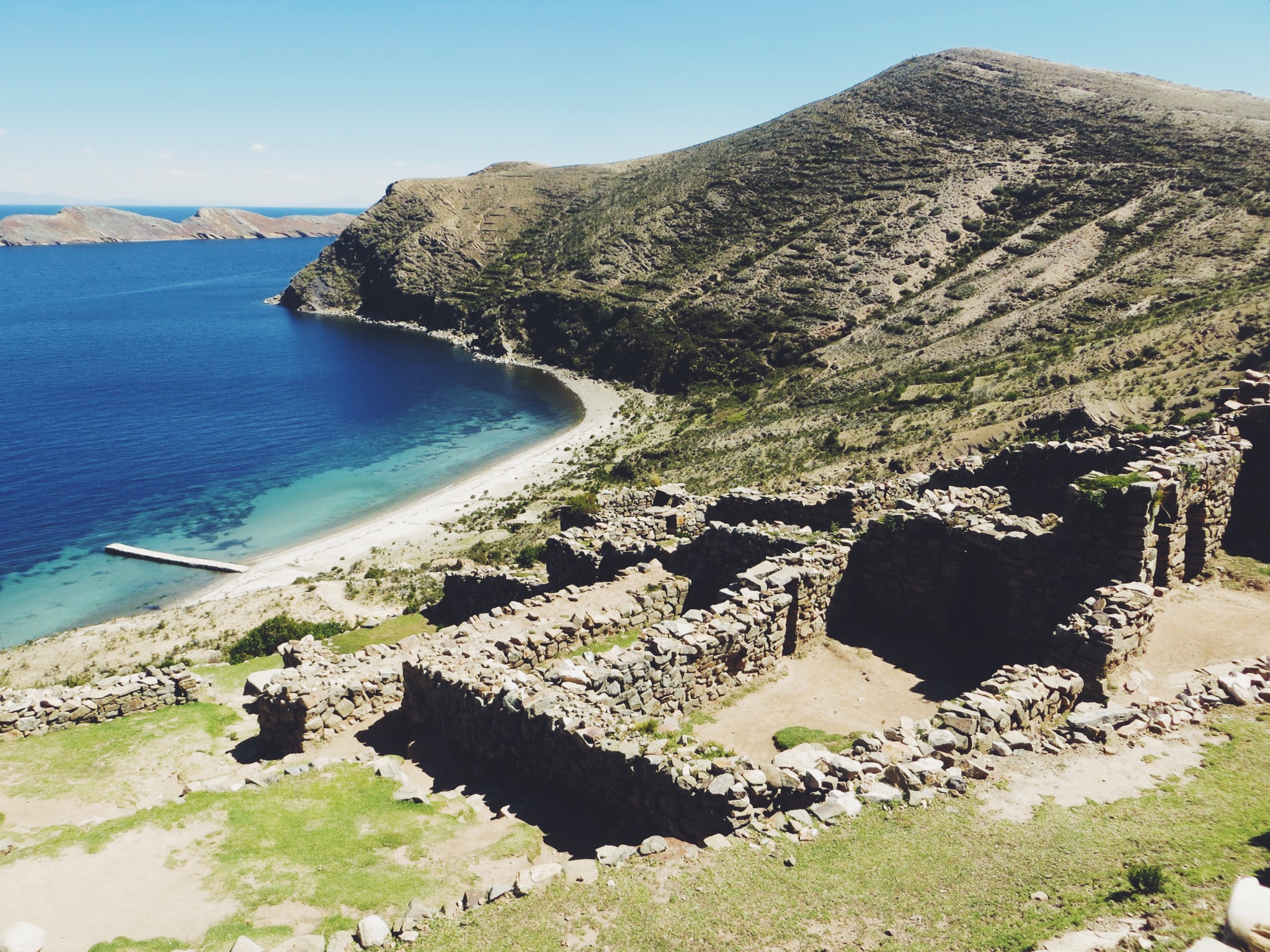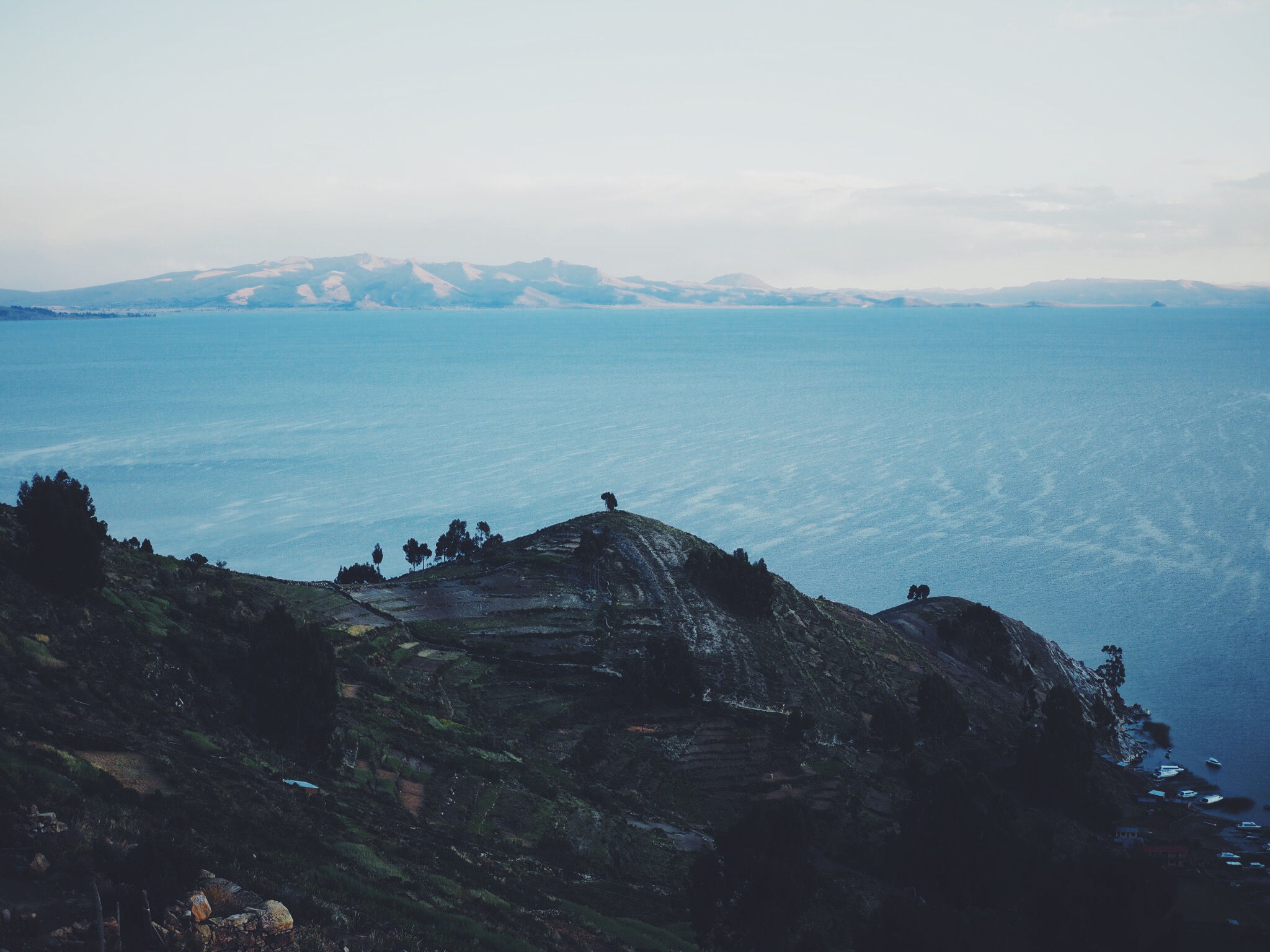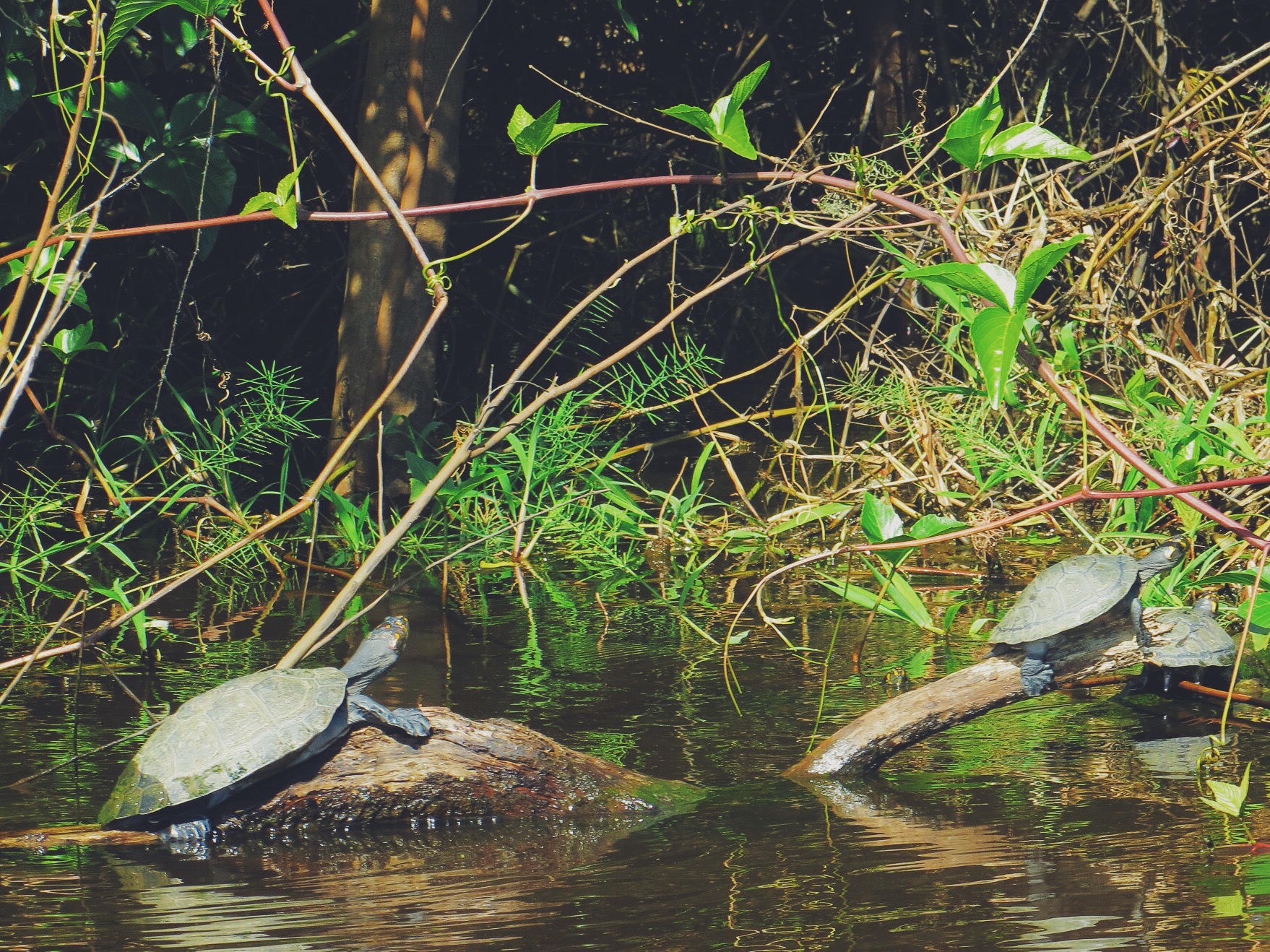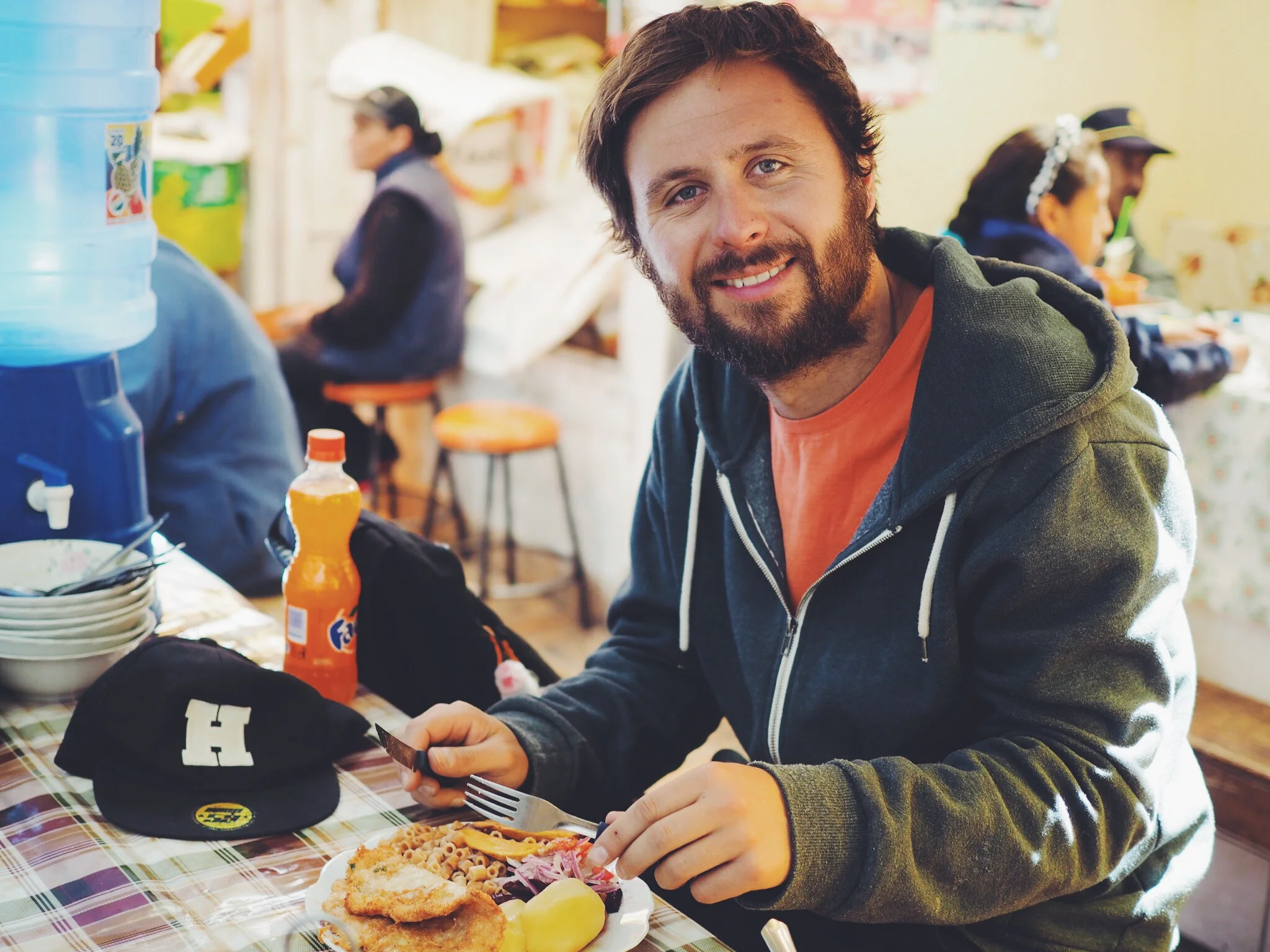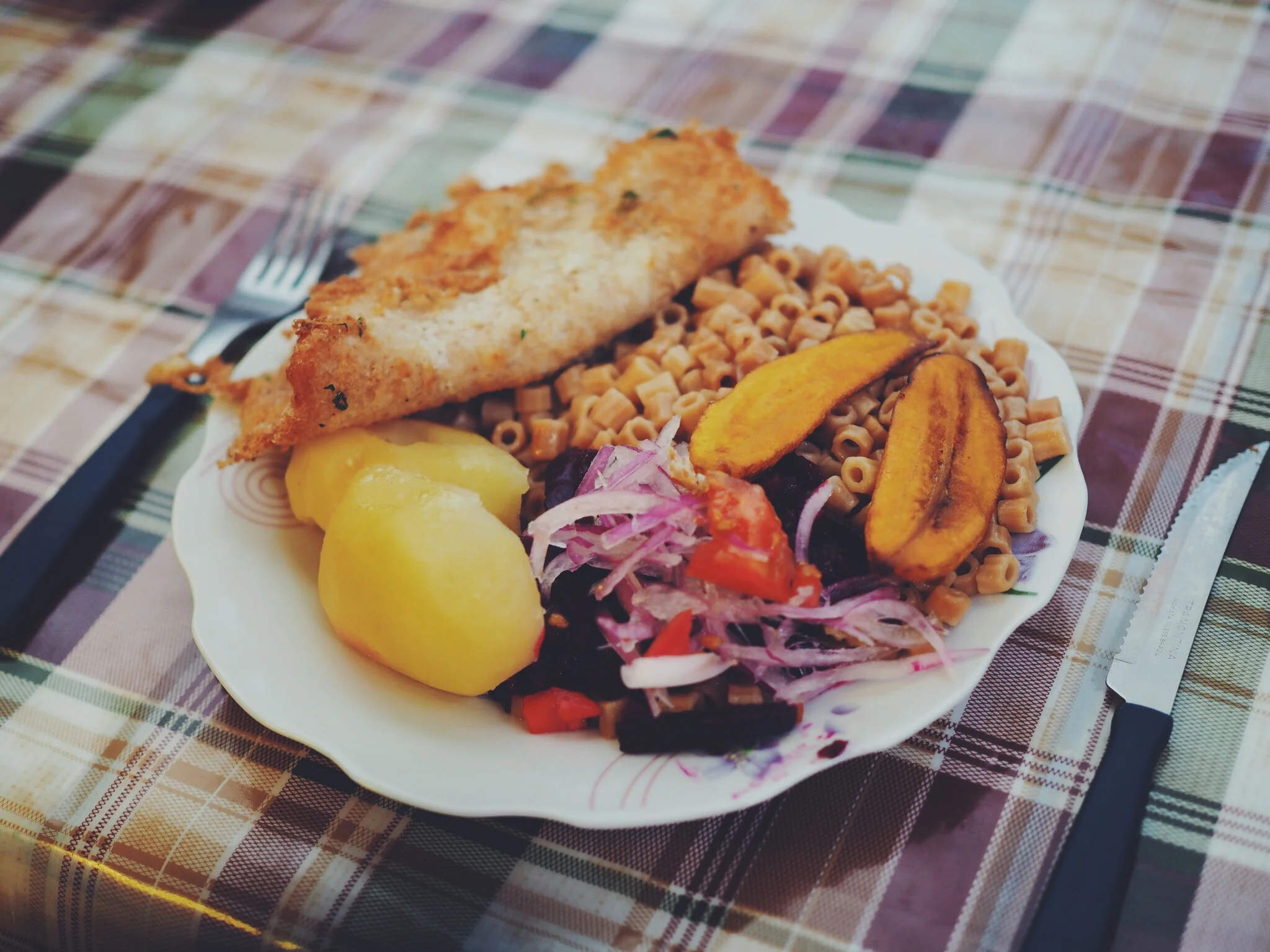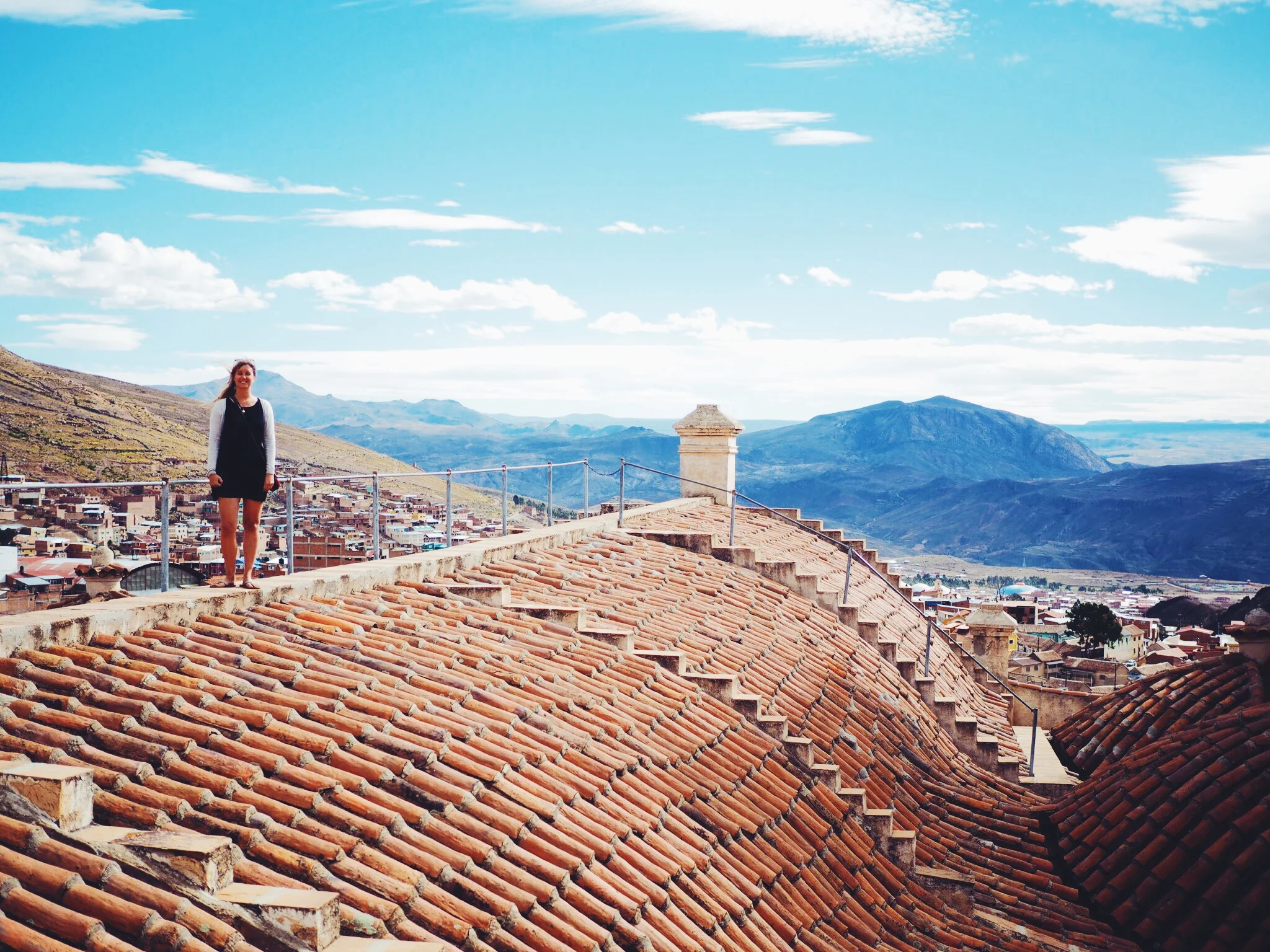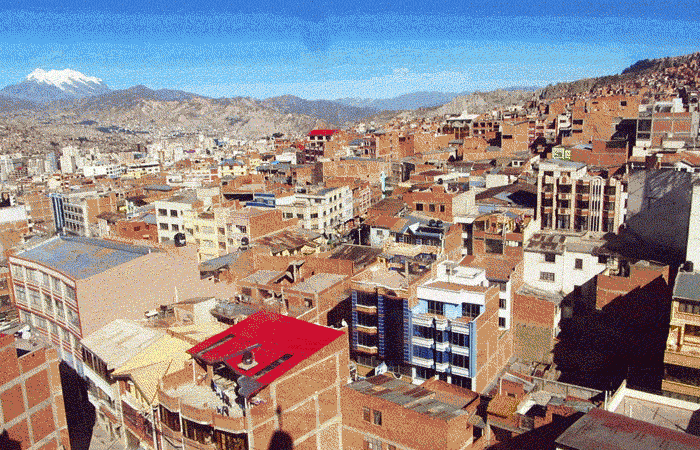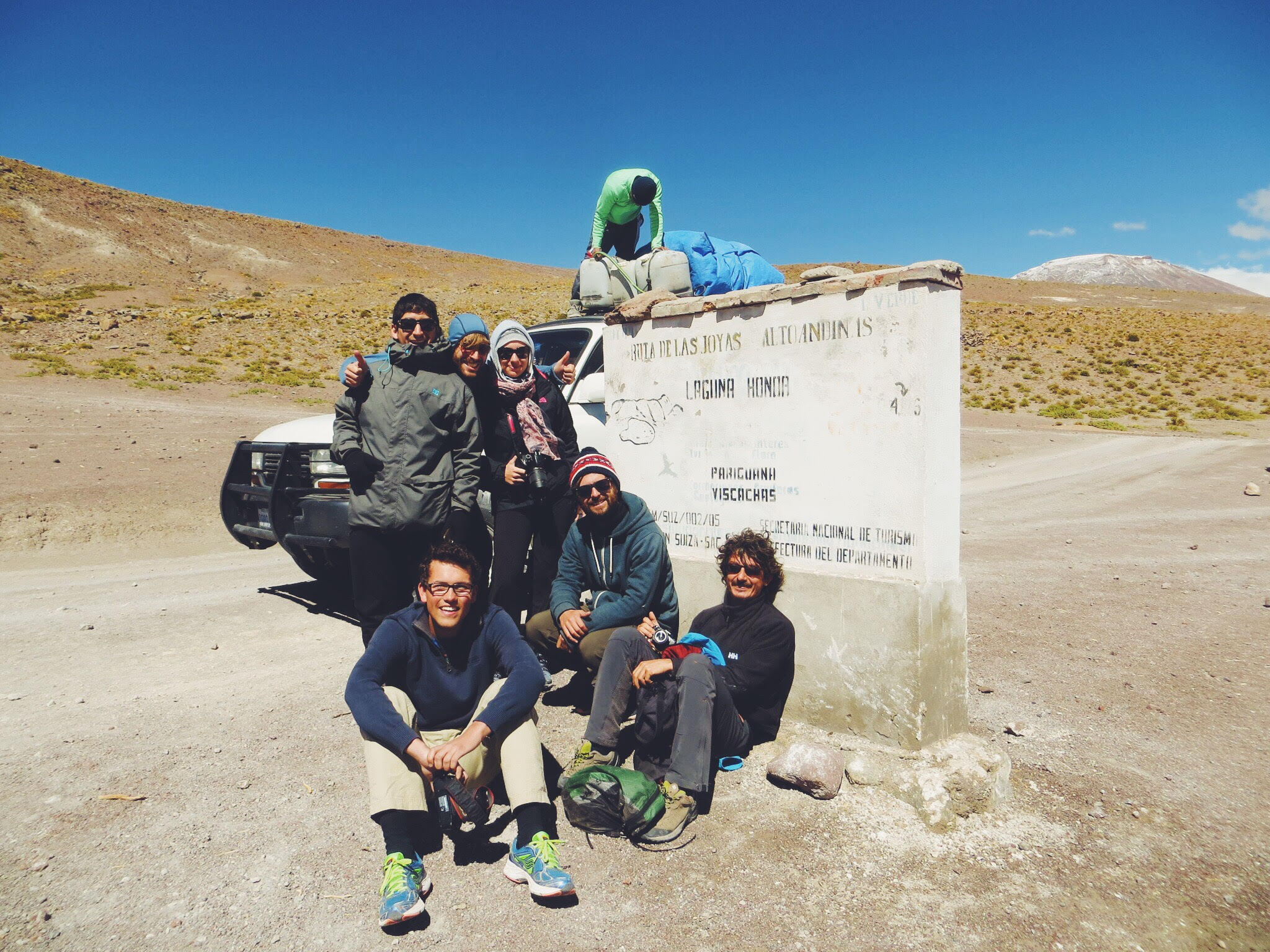Lake Titicaca
Our final stop in Bolivia was Lake Titicaca, the highest navigable lake in the world set at 3,800 meters above sea level. Home to a number of beautiful islands with breathtaking scenery, trekking opportunities and a chance to meet the local communities inhabiting them, it was a place we were very much looking forward to exploring. From La Paz we took a ‘Collectivo’ (a cheap minivan that takes groups of around 12) that wound through the mountains of northern Bolivia, and after a short ferry crossing we arrived at the lakeside city of Copacabana.
Copacabana
Copacabana is a small, picturesque city situated on the south of Lake Titicaca, nestled amongst two mountains and with a long, thin beach lining the waters edge. It is also the main city from which to explore the beautiful Isla Del Sol, or Island of the Sun. We arrived late afternoon and settled into Hostal Florencia, which was fairly basic but good value, and boasted a great view of the Basilica de Nuestra Señora de Copacabana.
We decided to visit the famous Cerro Calvario hilltop to get the best view of Copacabana. Feeling adventurous we took the 'off road' path which, retrospectively, wasn't a wise choice as we weren't feeling 100% due to the altitude. Although short, the hike was steep and challenging, but after a lot of panting and feeling faint we finally reached the top. We were greeted with an amazing view of the entire city; it was definitely worth the effort. It was great to get an idea of the sheer size of Lake Titicaca from above, a mass of water that spans over 8,000km.
We spent half an hour or so at the top to catch our breath before taking the much easier and gentler route down via the stone steps on the other side, leading us back down to the city square. We then visited the main landmark of city, the ‘Basilica de Nuestra Señora de Copacabana’. We’d seen quite a few colonial churches whilst travelling South America, but this one stood out with a strikingly colourful ceiling inside, painted in reds, blues and yellows (quite rare for a catholic church!). After walking around the courtyard and taking in the beautiful interior we headed back to our hostel for a rest after an altitude-intense day!
We had read great reviews about the food at Hostal La Cúpula, so that evening decided to pay it a visit. As it was so popular, we had to wait a while on their outside terrace for a table, and although it was pretty chilly out we loved taking the interesting architecture and bespoke design features. We ordered the freshly grilled trout (famous in Lake Titicaca) with native vegetables, which was delicious. By chance we saw a Welsh couple that we had previously met in La Paz, so once finished they invited us to their table and we spent the evening exchanging tales and swapping travel tips. We took their advice and booked into a hot tub next to the restaurant, and spent an hour watching the stars from our own private hill top pool.
Isla del Sol
The next morning we were up early to pack our light day bags, and boarded the 8.30am ferry to the north side of our first island visit in Lake Titicaca: Isla del Sol. The journey was slower that we were initially told (taking around 3 hours) which was a bit tedious, but on board was a girl we had previously met in Florianopolis, so we passed the time catching up on our travels since we had left Brazil. The weather was perfect for hiking, and as we pulled into the docks we started to see the beautiful rugged landscapes of Isla del Sol.
After landing and buying an entrance ticket we set off with a small group of others to trek from the north to the south side of the island. Along the way we were treated to views of crystal clear waters, green mountains and beautiful white beaches. The air temperature and water were colder than it looked due to the altitude, but once we got going it was perfect hiking weather.
We reached the look out point to get some photos of the view, and visited the Palacio del Inca ruins, a maze of stone walls also known as the Labyrinth. We also saw the Titi Qala, or Mountain Cat Stone, a large outcrop with a crag where at sun rise the sun shines right through. The Incas believed that this was the birthplace of the sun, hence the name Isla del Sol, and was therefore a frequent pilgrimage destination for the Incas. We then continued onwards uphill towards the south side of the island.
Our travel companions we're catching the 4pm ferry home, so once we reached the south side, they had to race down to try and catch the boat before it left. Luckily we had decided to spend the night on the island, and so checked into a hostel that we had researched the day before. The hostel was very quiet, and there was a lovely Cholita host who led us up to the top floor room that boasted amazing views over the lake.
We wanted to finish the hike so we headed down the steep steps (Escalera del Inca) towards the harbour, walking past the gently flowing Inca stream and taking in the small southern village of Yumani. We then shared a cheap lunch on a water-side restaurant watching the local girls loading up donkeys with supplies.
As our hostel had an amazing location situated at the top of the island it mean we had to take the steep path back up to the top, which was pretty tiring after a full day of trekking. There were no roads or cars on Isla del Sol, only cobbled paths, and as we continued we started to get out of breath it became clear how vital the donkeys were for carrying produce up and down the steep hills.
We reached our hostel just before sunset, wrapped ourselves up in a warm blanket and watched the sun set over the amazing Lake Titicaca. It was that moment we fell in love with the island; there was barely a sound apart from the occasional disgruntled Mule, and there was not a person in sight as we watched the sky turn orange over the tranquil turquoise water.
We were keen to visit the best restaurant on the island, Las Velas (the candels), which was hidden in the nearby forest. After getting completely lost in the dark for over 20 minutes, we eventually found the small homestyle restaurant nestled amongst the trees. It was wonderfully rustic, and as the name suggested, was only lit by candle light with two 'gourmet chefs' in their simple domestic kitchen.
After ordering we were given card games to play while we waited for our food, and we sampled a bottle of the local Bolivian wine, which was surprisingly good. We ordered the pizza and trout, which were both great, and as we were last to leave we enjoyed chatting to our cook afterwards. We headed back through the forest to our hostel under an amazingly starry sky with total silence around us.
Puno
After a final night in Copacabana we took a cheap bus across the Peruvian border, aided by a lovely bus conductor who advised us to change our Bolivianos at the border for a very reasonable rate! We passed by green and gold fields and more stunning blue lake as we approached Puno, the first Peruvian city of our trip. Unfortunately, by the time we had arrived in Puno and checked into a hostel we realised that the food (we suspect the trout!) at the lovely Las Velas restaurant had given us dodgy stomachs, and so we had to spend a couple of days recovering, watching films and eating chicken noodle soup. We actually welcomed the down time, as it had been quite intense travel over the past few weeks.
Puno itself isn't known for its sights, and is mainly used as a launch pad from which to visit the nearby islands, and so we were surprised to find a pretty square with a nice church. After scouting out various island tours we decided on the one offered by our hostel, and once everything was sorted we took the chance to relax for a few hours. That evening we went to Mojsa Restaurant, arguably one of the best in Puno, and got a balcony table overlooking the main square. We had excellently prepared Chimichurri steak and (fresh!) grilled trout with native vegetables, and after feeling well fed we headed back to the hostel to get a good nights rest before our trip to the islands.
Uros Floating Islands
We were picked up from our hostel around 8am and headed in a cab to the docks to board our tour boat. Within half an hour of setting off we were surrounded by the intriguing floating islands of Uros. The islands themselves were constructed from the native totora reeds and were originally built so that they could be moved when under attack, mainly during the Spanish colonisation. Now-a-days there are 42 islands, all of which are still constructed in the traditional way. However, not all residents live permanently on these islands, and many of the locals use them as means of making money through tourism, making them feel a little less authentic than we originally thought.
As we boarded the first floating island, it was very cool to feel the movement of the ground beneath our feet, and the traditional huts looked very quaint amongst the reeds. Our group were given a short but informative presentation on the construction of the islands, which we learnt was made by lashing together 2-meter-thick blocks of khili roots with eucalyptus rods, and placing criss-crossed layers of totora reeds on top.
We were then split into small groups and taken into the little reeds huts owned by the locals. We asked the locals some questions about their life on Uros, although we realised the main purpose of entering the huts was to be sold textiles and other trinkets they had made. We decided not to buy anything, but offered a small tip to the locals instead.
We then boarded a traditional reed boat (or ‘Mercedes Benz’ as the locals called them) for an extra few Soles, and sailed to the neighbouring island about 15 minutes away. The local kids began to sing different European songs to us for tips (a little gimmicky!) but it was fun to experience an age-old mode of transport none the less. As we reached the larger floating island we found there were small restaurants, reed archways, many trinket sellers, and even a very small trout farm in the centre.
After exploring the second floating island we returned to the boat, and continued on our tour to the next stop, Amantaní island. We left feeling like Uros was a bit of 'tourist show', and it would have been nice to also see the current, more authentic lifestyle of the locals on the islands, regardless of what traditions had been lost. Overall the floating islands was an interesting experience for us, and we loved seeing the traditional methods used to make the boats, handicrafts and the islands themselves.
Amantaní Island
Our next stop was Amantani island, a 2 hour boat ride from Uros. We pulled up to the island where a group of around 20 traditionally-dressed local women were waiting to take us to our separate home stays. After most of the groups were selected, we were introduced to a young girl called Seneda, who was only 14 years old. We assumed she was the daughter of our host, but after she led us up the hill to a humble but cosy house we realised she was going to be taking care of us for the next 2 days!
After being shown our room, Seneda set about preparing our lunch, and we soon realised that she was more than capable of looking after two travellers by herself. Having never been in a 'home-stay' before we felt a little awkward being catered for, and so went down to the kitchen to offer to help. Our communication wasn't great (our Spanish is still rusty!) so she set us to work peeling potatoes to keep us busy. Without a peeler we were pretty slow, and after her laughing at our attempts she showed us her amazingly efficient knife-peeling technique.
It was a simple but tasty lunch of soup, potatoes, veg and cheese, and after we had eaten all we could we were introduced to Senadas two younger brothers. The youngest, who was 3, was the happiest child we had ever met, and we spent a fun hour drawing, terrorising the guinea pigs (him not us!), playing ball and swinging him around. It was great to be able to meet such a fun little character during our stay, especially as the language barrier wasn't an issue!
Senada then led us up to the main path of the village to meet with the rest of the group and hike to the Centro Ceremonial Pachatata ruins to watch the sunset. As we waited for the other members of our group we watched the herds of sheep pass, shepherded by the local girls, and once all assembled we started to hike to the highest point of the island.
It was an easy-going trek that snaked up an old stone path, passing inca-style terracing and farmland, and by the time we reached the top we bought a lovely alpaca wool scarf from a local woman, found a comfortable spot and waited for the sun to go down. Lake Titicaca is sometimes referred to as the 'silver lake' due to the metallic sheen effect created by the sun, and from the hilltop we understood why it got its name. It was another beautiful sunset and great view showing off the ever impressive expanse of water.
Once it started to get dark we headed back down to our little home for dinner, and were told we needed to get changed into traditional clothing for a small party that evening! It was fun being dressed in their hats and ponchos, even though we felt a bit ridiculous, but as we walked in the pitch black to the local village hall, thankfully we realised all the other tourists were dressed the same. We then spent a slightly awkward hour attempting to follow the Peruvian dance moves to a very repetitive local band. Fortunately the dancing didn't last long and after a little while of chatting to other travellers in colourful hats, frocks and ponchos we headed back for bed.
The following day Senada was up early to make us breakfast, and by the time we were up and ready her grandmother and mother had arrived at the house. After meeting her mother we were really pleased that Senada had been our host, as we doubt we would have had as much fun if her mother had been looking after us. After our goodbyes, and big hugs from Senada’s youngest brother we were led back to the harbour and waited for the boat to pick us up.
Taquille Island
After leaving Amantani we headed to our final stop, Taquille Island. On the journey there our guide explained the differences in the clothing between the island's residents; on Taquille the women wore black dresses with colourful embroidery, and the men wore colourful hats with pom moms (the larger pom moms indicated a single man, smaller pom pom indicated married). Our guide also explained how the men of the island wore intricately hand-woven belts by their wives, with embroidery communicating the story of how they met, and actual hair of the woman interwoven into the fabric. On arrival we started to see the locals in their traditional clothing dotted around the island, and after a short hike to the top of the hill we wandered around the market stalls in the main square.
We then continued to a small hillside restaurant where we were given a short demonstration of the how the locals extracted soap from the native plants, and used it to turn brown alpaca fibres used in many of their textiles to a brilliant white. After the demonstration we ordered from the lunch menu, chatted to the other tour members and basked in the sun until it was time to leave. Once we got back in the boat we dozed off during the 3 hour journey. We were woken abruptly about 10 minutes from Puno as the steering of the boat had broken, resulting in us crashing into the side of a floating island! It took a little while to correct our positioning, and the captain had to use long poles to push us away from the bank, before using the back rudder to steer us safely back to Puno.
The scenery, traditions and local people of Lake Titicaca were pretty much unknown to us before we set off on our trip, but after visiting both the Bolivian and Peruvian sides of the lake we were so glad we had included it in our itinerary. From hiking through the peaceful Isla del Sol to floating on the reeds of Uros, making ourselves at home with a local family on Anamtani island to seeing the traditional clothing of the locals on Taquille, our visit was both varied and rewarding in terms of landscapes and culture. Our next stop was Cusco, and it was satisfying to leave Puno with an initial understanding of Peruvian culture before our trip to the ever popular Machu Picchu.



















